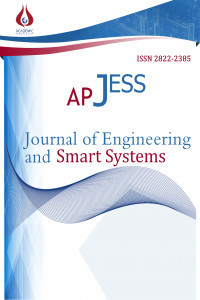Bulanık Mantık Yaklaşımıyla Uzun Dönemli Stajyerlerin Firma Yerlerinin Belirlenmesi: Uygulamalı Eğitim Modelinde Uygulanması
Birden fazla değişkenin olduğu iş gücü talep eşleştirmesi problemlerinde en uygun eşleştirmenin yapılması oldukça uzun ve zorlu bir süreçtir. İş gücü ve talebin dengeli dağılımı sadece iş hayatında değil eğitim hayatında da önemli bir yere sahiptir. Bu çalışmada Sakarya Üniversitesi Endüstri Mühendisliği Bölümü'nde uygulanan Uygulamalı Mühendislik Deneyimi Eğitimi (UMDE) programındaki öğrencilerin en uygun işletmeye atanması hedeflenmiştir. Bu amaçla hem öğrenci bilgi ve deneyimi hem de firma talepleri dikkate alınmıştır. Problemin çok değişkenli bir problem olması ve bu değişkenlerin kesin değerleri olmamasından dolayı Bulanık Mantık yaklaşımı kullanılmıştır. MATLAB yazılımı ile yapılan değerlendirmeler MS Excel programında işlenerek atama işlemi tamamlanmıştır.
Anahtar Kelimeler:
Bulanık Mantık, Uygulamalı Eğitim, UMDE, Atama Problemi
Determination of Companies for Long-Term Internships with Fuzzy Logic Approach: An Implementation of Cooperative Education Model
It is a very long and difficult process to make the most suitable matching in the work force demand matching problems with more than one variable. The balanced distribution of labor supply and labor demand has an important position not only in business life but also in education life. In this study, it is aimed to assign the students in the Applied Engineering Experience Education (UMDE) program applied in Sakarya University Industrial Engineering Department to the most suitable enterprise. For this purpose, both student knowledge and experience and company demands were taken into consideration. The Fuzzy Logic approach is used because the problem is a multivariate problem and these variables do not have crisp values. Evaluations made with MATLAB software were processed in MS Excel program and assignment process was completed.
Keywords:
Fuzzy Logic, Cooperative Education, UMDE, Assignment Problem,
___
- [1] Parisa Shahnazari-Shahrezaei, Reza Tavakkoli-Moghaddam, Hamed Kazemipoor, «Solving a multi-objective multi-skilled manpower scheduling model by a fuzzy goal programming approach,» Applied Mathematical Modelling, 2013.
- [2] Y. Naveh, Y. Richter,Y. Altshuler,D. L. Gresh,D. P. Connors, «Workforce optimization:Identification and assignment of professional workers using constraint programming,» IEEE, 2007.
- [3] Mangesh Gharote, Rahul Patil , Sachin Lodha , Rajiv Raman, «Assignment of trainees to software project requirements: A stable,» Science Direct, 2015.
- [4] Luis Daniel Otero, Grisselle Centeno,Alex J. Ruiz-Torres,Carlos E. Otero, «A Systematic Approach for Resource Allocation in Software Projects,» Science Direct, 2008.
- [5] Thomas L. Saatya, Kirti Peniwati,Jen S. Shang, «The analytic hierarchy process and human resource allocation: Half the Story,» Science Direct, 2007.
- [6] Jie Liana, ChenGuang Liub,WenJuan Li,Yong Yin, «A multi-skilled worker assignment problem in seru production systems considering the worker heterogeneity,» Computers & Industrial Engineering, 2018.
- [7] Aşkın Demirkol, Zafer Demir, «BULANlK SINIFLAMA,» Saü Fen Bilimleri Enstitüsü Dergisi, 2000.
- [8] Aşkın Demirkol, Zafer Demir, «Bulanık Sınıflama Yöntemi İle D.C. Motorlardaki Arıza Ve Sebeplerinin Teşhisi,» Sakarya Üniversitesi Fen Bilimleri Enstitüsü Dergisi, 1999.
- [9] H. Yeşiltaş, Bulanık Mantık İle Proses Kontrolü Ve Cam Elyaf Takviyeli Polyester Boru Fabrikasında Uygulama, Sakarya, 2016.
- [10] Aydin SALIMIASL, Mohammad RAFIGHI, «Titreşim ve Kesme Kuvveti Esaslı Takım Aşınmasının,» Politeknik Dergisi, pp. 111-120, 2017.
- [11] C. Kubat, Matlab - Yapay Zeka ve Mühendislik Uygulamaları, Sakarya: Beşiz Yayınları, 2012.
- Yayın Aralığı: Yılda 3 Sayı
- Başlangıç: 2022
- Yayıncı: Akademik Perspektif Derneği
Sayıdaki Diğer Makaleler
Toz Metalurjisi Yöntemiyle Mg-Sn Alaşımı Üretimi ve Karakterizasyonu
Bira Endüstrisi Atıksularının Elektrokoagülasyon ile Arıtımı ve Hibrit Elektrot Bağlantısının Etkisi
Mahmut PAKSOY, Gökhan KARARSIZ, Muzaffer METİN
Usman Kayode ABDULRASAQ, İnci AYRANCİ
Hanife PALABIYIK, İbrahim ÇİL, Merve CENGİZ TOKLU
Numerical Investigation for Moment-Curvature Relationship of CFRP Jacketed RC Columns
M. Nadir Olabi, Naci ÇAĞLAR, Nurdan G. KOROGLU
Determination of Ceramic Cutting Tool Performance on Machining of Steel (PMD23) Produced by Powder
Bitkilerde Tuz Toleransının Fizyolojik ve Biyokimyasal Bileşenleri
